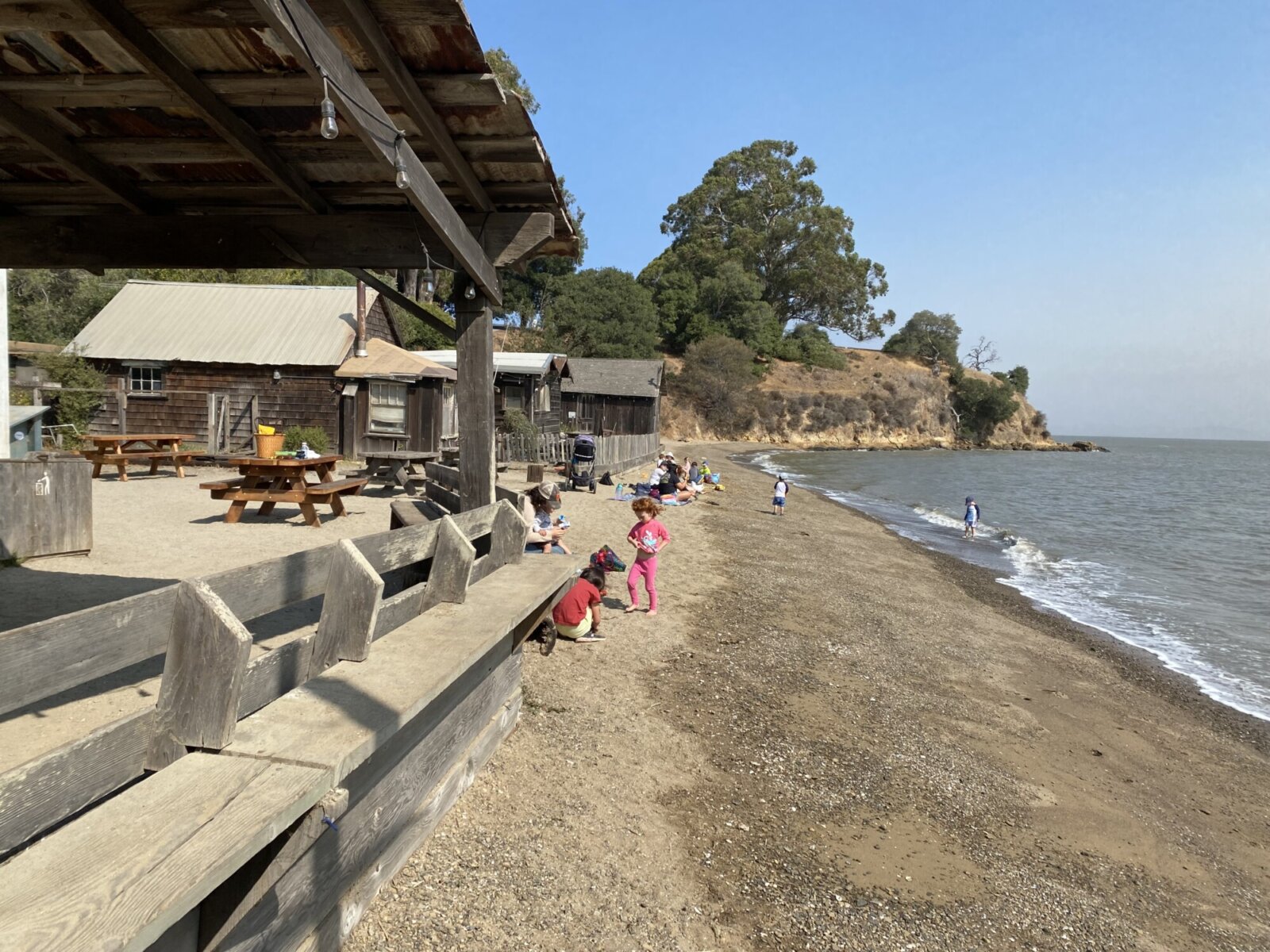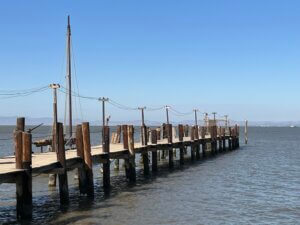
The gentle act of preserving history
Our historic preservation expert John Muir shares insights on the restoration of China Camp Village
Aging pilings, weather-worn rooftops, the constant tug of gravity, storms and waves—China Camp Village has withstood so much over the years. And it faces an uncertain future, with the very real threat of rising sea levels due to climate change.
For Friends of China Camp, preserving the village is one of its most important responsibilities: helping to thoughtfully and carefully preserve this unique collection of vintage buildings on the edge of San Pablo Bay. To find out more about these challenges, and what’s in store for the village, we turned to volunteer and Friends of China Camp board member John Muir, a historical preservation expert and the curator of small crafts at the San Francisco Maritime National Historic Park.
What projects are now underway at China Camp Village?
In addition to the major ADA work being managed by California State Parks, there are things going on all over the place. Mostly it’s long-term, ongoing maintenance to fight the ravages of time and nature. At China Camp, we’re trying to hold it in a place of “arrested decay,” the balancing point between restored, or old and standing, or collapsed. Of course that’s part of the charm of China Camp Village—it appears old and has that old-time charm and feel, but it does need to stay standing. We want to keep everything safe and secure yet tied to the past—sort of frozen in time. It’s an obligation as a historic district not to change things too drastically.
One of the things we’ve tackled—mostly by our volunteers—is the pier. We’ve been replacing the fence at the end of the pier, and putting in new planking. We’ve also been restoring the fence around Frank Quan’s houses. That’s the kind of decay that we’re always fighting, and will probably fight forever.
Are there major projects at the village coming up for FOCC?

Looming now is restoratiof the cafe rooftop. For a couple of years, a mother raccoon has decided to make a nest for herself there. She has pulled up shingles and found a nice warm space between the interior ceiling and the shingles. For the last two springtimes, we’ve been battling her. You can see plywood we’ve put up there, trying to dissuade her from digging in. So that’s our big job for the fall, removing the other repairs and replacing the historic shingles.
We’ll also be correcting some of the poor judgment used in a previous roof restoration, which used wire staples and wire nails to hold the shingles. The flexing of the wood due to the rain and the heat made the shingles very loose and easy for the raccoon to tear up. This time, we will use original nails and historic cedar shingles to restore the section of the roof that we’ve been trying to defend. And the State is sending a shingle-roof expert to coach us and help us understand how to do the job right.
Last winter’s weather was pretty rough. What kind of damage have you had to deal with to date, and what’s in store?
The bulkhead fronting Frank Quan’s houses along the beach got taken away by the high seas. We re-dug and restored the bulkhead. But the biggest damage was along the pier, where there was a deck used for sorting shrimp in the old days. It’s where they’d cook the shrimp and pour them out into shakers, where they’d separate the big shrimp from the little shrimp. That whole deck was lifted up and broken apart by the waves, blocking all access to the museum, as well as damaging the underpinning of the ADA project in front of the museum. We scrambled to regain access to the museum, and got it fixed, for the most part using mostly original materials.
So there’s the slow decay of time, and the quicker decay from storms and raccoons. That’s what we’re fighting and trying to counter now.
How old are the buildings in the village? Are they all from the late 1800s, when the village was booming as a shrimp-fishing camp?
There are still a few buildings from the 1890s. But a lot of the buildings were built during the ‘20s and 30s—what we call the “Quan Brothers phase,” when fishermen from elsewhere in the bay brought their shrimp to the village, and sport fishermen rented boats from the Quans and bought drinks and shrimp. In a lot of cases the Quans were recycling materials from the old buildings to build new ones.
What do you consider to be the most important building to try to preserve right now?
The older ones, the ones that really showed the shrimp processing both before and during the Quan period. Those would be the buildings around the pier, where they boiled, sorted, and washed the shrimp. And the winnowing shed behind the cafe, which is probably the oldest building in the village. The floor is collapsing—it’s sensitive.
There’s an old green shack collapsing at the end of the village parking lot. What was it used for historically, and what happens to it now?
It was a residence in the late 1930s and ’40s. It’s been collapsing in on itself. We’re working with the State to potentially document it with digital photographs. If we discover that it’s too far gone, we will assess the possibility of removing it.
Why can’t we just fix the green shack, or other historic buildings?
Friends of China Camp’s work needs to be very carefully coordinated with California State Parks and the California Office of Historic Preservation, because the village has protected status. That’s why we can’t just go and fix it. We have to try the best we can to use historic materials and techniques, and be sensitive so we don’t change inherent information in the building.
The big challenge is the time it takes for permits, revisions, and review. But I think it’s almost designed to be that way, to keep things moving slowly and not moving too fast, so things happen carefully. That’s the general mode. As a lifelong preservationist and working in a bureaucracy, it certainly can be a frustration. But the slower pace can be important.
What do you see as the biggest threat to the village?

Sea-level rise. Even where I work at Hyde Street Pier in San Francisco, workers are rebuilding a pier and adding six feet to it, making it higher off the water. Everyone’s starting to adjust their long-term plans. But China Camp has a really urgent need. It’s very vulnerable and fragile. It’s going to be very interesting—hopefully not in a bad way—seeing what happens.
Is there anything the public can do?
Yes! If there are preservationists out there, they can get involved. And if people love the village, they can donate to Friends of China Camp. All the money goes to the park, and to our restoration efforts.
I hope we can do this right, and I think we can. The beauty and the uniqueness and setting of the place—and the passion for it—that’s all an ace in the hole for us. The place seems to have a way of taking care of itself, and it has lasted for many, many years. It’s inspiring, and I hope it keeps inspiring people.
—interview by Harriot Manley/FOCC volunteer

